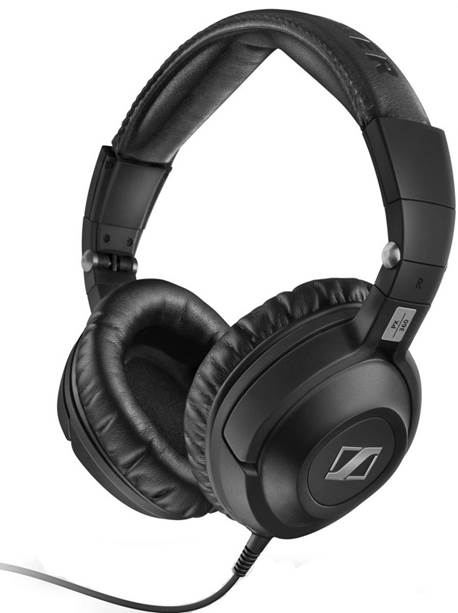Sennheiser PX 360: $178.5
Unsurprisingly for this company perhaps,
this phone proves a capable all-rounder…
Details
·
Origin: Germany/Ireland
·
Type: closed-back
·
Weight: 163g
·
Features: Duofoil drivers
·
Neodymium magnets
·
Folding design
·
Distributor: Sennheiser
·
Website: sennheiser.com
Senheiser has a range of headphones and
earphones that makes ‘extensive’ look a little inadequate. At the test price
point it makes some conventional full size home headphones, but also been
getting into smaller designs that are able to work on the move too. The PX 360
is one of these models and is also available in a Bluetooth variant. The PX
prefix is from the portable line, but the design is more in keeping with the HD
range.
This design intention means that the PX 360
is one of the smaller designs here. As well as rotating flat, the earpads and
reduce space further. This does give the PX 360 a rather unusual shape – it
almost looks ‘bow legged’ from the front as the widest point of the headphone
is the hinge above the earpad. The pads themselves are closed-back types that
sit slightly awkwardly between covering the ear and sitting on it. That said
the PX 360 is comfortable in use. It employs a pair Duofol diaphragms with the obligatory
Neodymium magnets for drivers. Fit and finish are extremely good, but the cord
is a little on the thin side and terminates at the right hand confusingly is
the opposite to everyone else.

This
design intention means that the PX 360 is one of the smaller designs here
Sound quality
The most distinct impression you get from
listening to the PX 360 is that the sound is similar to the Grado, in that it
is extremely cohesive from top to bottom with no frequency either recessed or
over emphasized. This gave the Kings of Leon and extremely listenable quality
that found the charm of the recording without exposing the weak points. The
handling of vocals in particular was extremely good and this headphone managed
a truly stirring performance with Martha Tilston. Detail proved excellent
without tripping over into brightness or harshness, and the supporting
instrumentation complements the performance extremely well.
Like the Grado, the soundstage is more
confined than some of the other designs in the test, but there is still a
convincing sense of the performance, as well as a strong sense of timing. There
isn’t quite the same bounce and attack to Hybrid and the Kings of Leon as the
Grado can manage, but this is still a very lively and assured performer that can
still do justice to more relaxed pieces of music and not force them. The
Sennheiser also has to yield to the Grado in terms of bass. There is plenty of
it and it starts and stops commendably fast, but there isn’t the last ounce of
detail that the Grado finds in the same pieces.

PX
360 is that the sound is similar to the Grado, in that it is extremely cohesive
from top to bottom with no frequency either recessed or over emphasized
The closed-back design and relatively
compact dimensions of the Px 360 does mean that it is an excellent headphone to
use on the move though. The isolation is excellent and even in noisy spaces the
Sennheiser does a good job of keeping the outside world at bay.
As an all-rounder then, the Sennheiser is
equally at home with your main system as it is on the move which is a harder
trick to pull off than you’d think. It’s fair to say that this is not quite the
best headphone here, but it certainly is a very fine sounding and comfortable
design that offers a great deal of real-world flexibility.
On test
With a sensitivity that’s 2dB higher than
the group average, the PX 360 should deliver ample sound level from any
headphone outlet. Capsule matching was excellent at  4.0dB, 40Hz to 10 kHz, and so too was the bass extension with -6dB
ref 200Hz occurring at a low 14Hz. But to achieve the capsules had to be
pressed against the artificial ear by hand during testing, despite a headband
clamping force which is already quite high. Impedance variation of 34.6 ohms to
48.5 ohms, 20 Hz- 20 kHz, gives the highest responses variation of the group of
0.59dB for a source impedance of 10 ohms, so use with a low impedance source is
advisable. At 178g the Sennheiser is the lightest headphone of the group.
Diffuse-filed correction of the frequency response shows a rise in output to
4.5dB above 1 kHz at 80Hz and alternate excess and shortfall in the presence
band.
4.0dB, 40Hz to 10 kHz, and so too was the bass extension with -6dB
ref 200Hz occurring at a low 14Hz. But to achieve the capsules had to be
pressed against the artificial ear by hand during testing, despite a headband
clamping force which is already quite high. Impedance variation of 34.6 ohms to
48.5 ohms, 20 Hz- 20 kHz, gives the highest responses variation of the group of
0.59dB for a source impedance of 10 ohms, so use with a low impedance source is
advisable. At 178g the Sennheiser is the lightest headphone of the group.
Diffuse-filed correction of the frequency response shows a rise in output to
4.5dB above 1 kHz at 80Hz and alternate excess and shortfall in the presence
band.

At
178g the Sennheiser is the lightest headphone of the group
|
Results at a
glance
§ Sensitivity:
+8%
§ Impedance
variation: -50%
§ Capsule
matching: +15%
§ LF
extension: +20%
§ Weight:
-20%
Our verdict
§ Sound
quality: 5/5
§ Value
money: 4.5/5
§ Build
quality: 4.5/5
§ Sensitivity:
4/5
§ Like:
highly cohesive and enjoyable sound; compact and well built
§ Dislike:
Slight lack of bass detail thin cord
§ We
say: A strong sonic performer that works at home or on the move – it
represent very good value for money indeed
§ Overall:
5/5
|